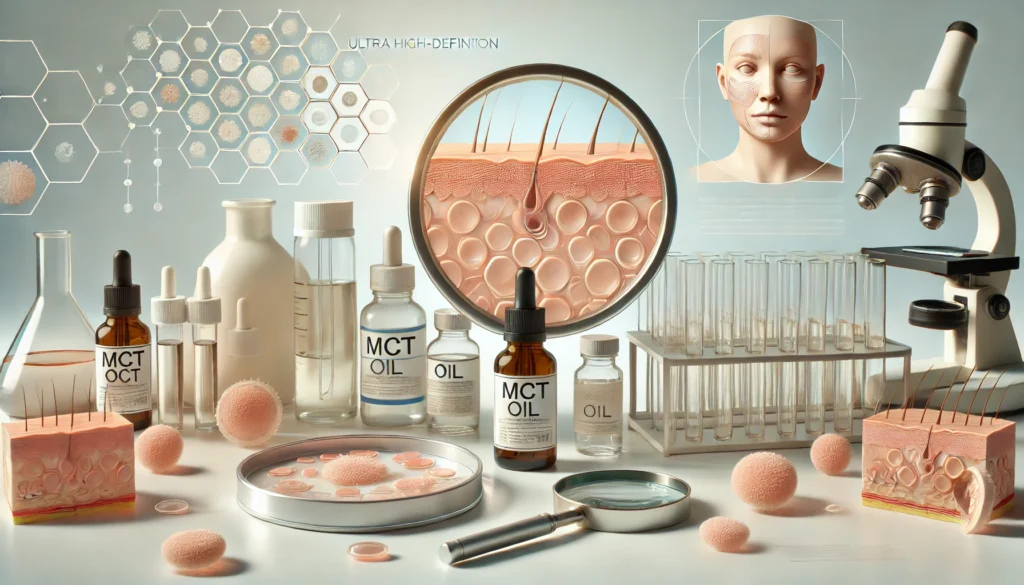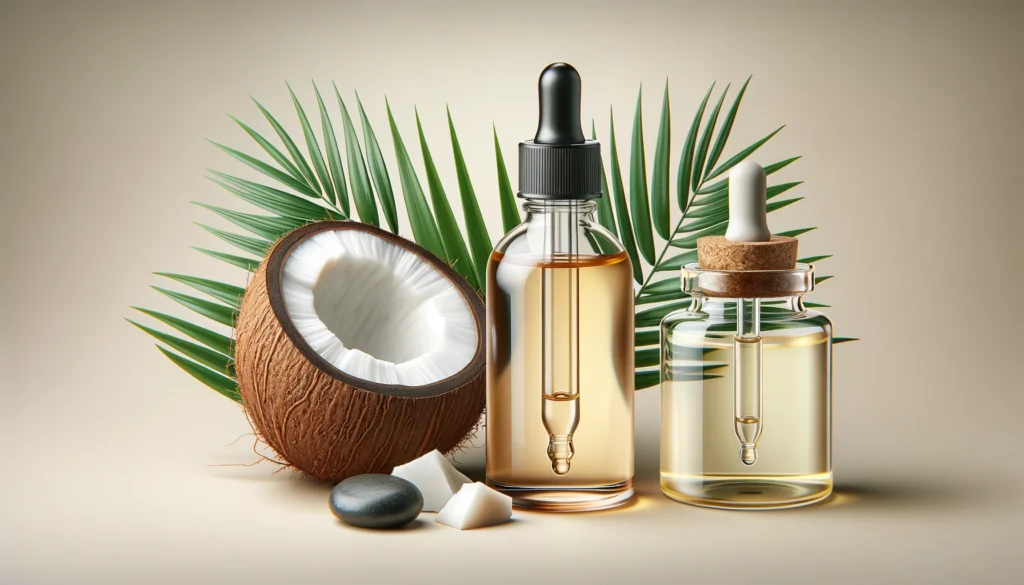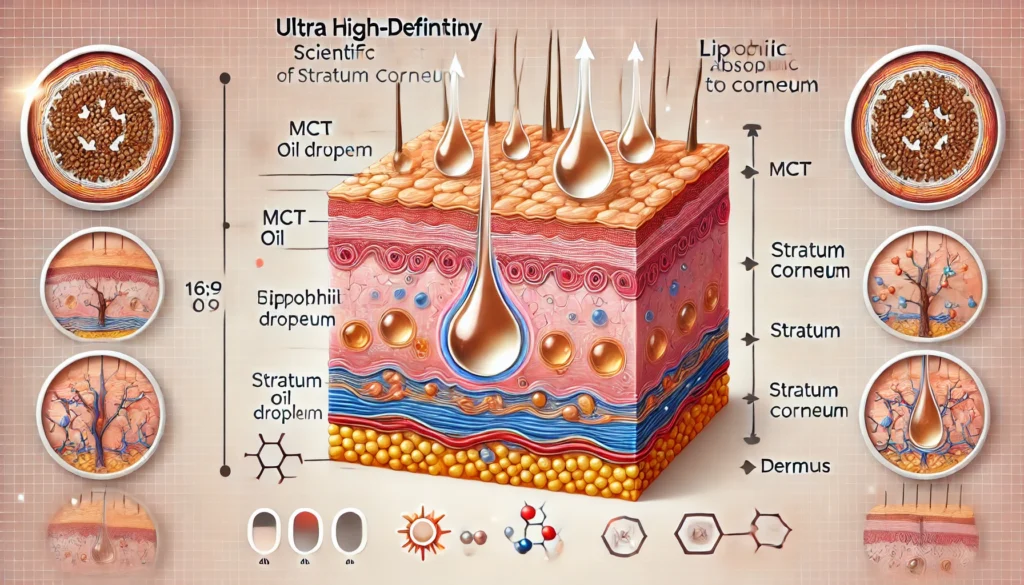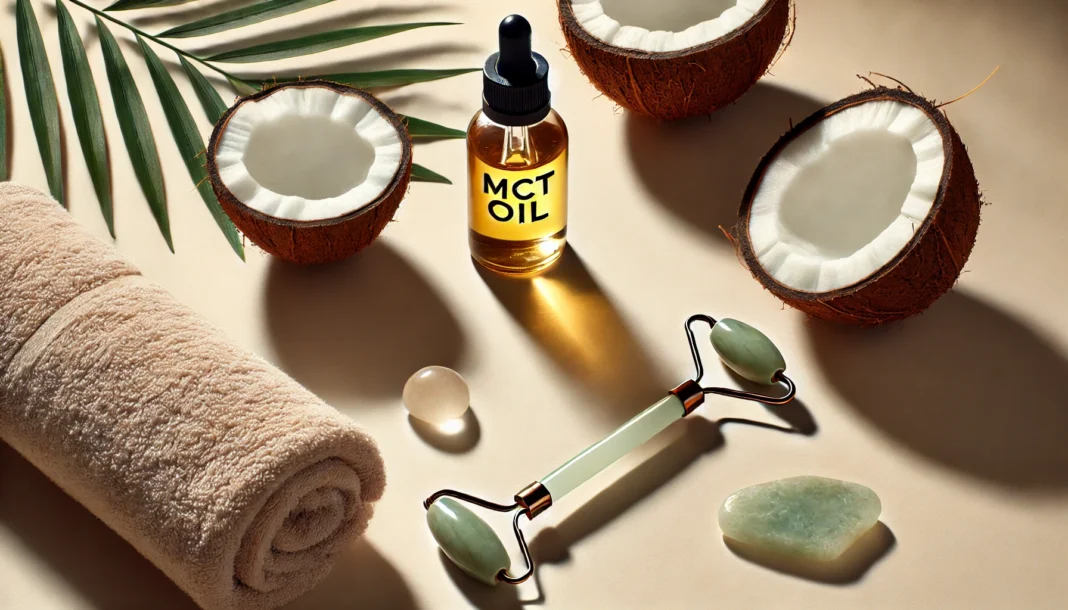Introduction
In the modern realm of functional skincare and holistic wellness, there is a growing demand for plant-derived ingredients that support the skin not only cosmetically but also physiologically. Among the many oils rising in popularity, MCT oil for skin has generated significant interest for its potential to hydrate, repair, and protect. Short for medium-chain triglycerides, MCT oil is a derivative typically sourced from coconut or palm kernel oil. It is well-known in nutritional and metabolic science for its rapid energy metabolism, but now, dermatologists and cosmetic chemists are increasingly exploring how MCT oil interacts with skin physiology.
You may also like: MCT Oil for Dementia and Brain Health: Exploring Its Role in Memory, Function, and Alzheimer’s Support
With claims circulating about its use in reducing inflammation, improving barrier function, and accelerating skin healing, consumers are asking: is MCT oil good for skin? Does it penetrate the skin barrier? How does it compare to other oils commonly used in topical products? As personal care routines lean more toward natural formulations and bioactive ingredients, these questions warrant thorough exploration. This article unpacks the benefits of MCT oil for skin by integrating dermatological science, lipid absorption mechanisms, and peer-reviewed clinical findings.
We will explore whether coconut MCT oil for skin differs from other formulations, how it interacts with the skin’s lipid layers, and finally, address the science behind whether or not MCT oil can be absorbed through the skin. For those seeking evidence-based answers in the evolving field of dermatological nutrition, this article aims to deliver clarity, credibility, and practical application.

What Is MCT Oil and How Is It Made?
MCT oil is a highly refined form of dietary fat consisting primarily of medium-chain triglycerides, which are saturated fatty acids containing between 6 and 12 carbon atoms. The most common MCTs include caprylic acid (C8), capric acid (C10), and lauric acid (C12). While all three can be found in natural coconut oil, they are isolated and concentrated in MCT oil through a process called fractionation. This technique separates the medium-chain fatty acids from long-chain counterparts, producing a lightweight, nearly odorless oil with enhanced stability and purity.
In the context of skincare, this refined oil offers a different lipid profile compared to traditional carrier oils like olive, jojoba, or even raw coconut oil. While the latter contain a wide array of fatty acids and bioactives, MCT oil focuses solely on medium-chain triglycerides, particularly caprylic and capric acids, which offer antimicrobial and anti-inflammatory potential.
Is MCT Oil Good for Skin? Exploring Dermatological Evidence
The question “is MCT oil good for skin?” invites both anecdotal endorsements and increasingly robust scientific support. Studies and clinical observations suggest that MCT oil may improve skin hydration, enhance lipid barrier function, and modulate skin inflammation, especially in conditions such as eczema or rosacea.
Medium-chain triglycerides are absorbed into the stratum corneum—the outermost layer of the skin—where they help restore lipid integrity. This supports the skin’s barrier function, reducing transepidermal water loss (TEWL) and increasing moisture retention. Moreover, caprylic and capric acids are naturally antimicrobial and may inhibit the proliferation of skin pathogens such as Staphylococcus aureus, a common contributor to eczema flare-ups and folliculitis.
Because of its molecular weight and polarity, MCT oil does not clog pores (it is considered non-comedogenic) and has been used effectively as a carrier oil in essential oil dilution for sensitive skin types. This makes it a versatile choice not only in facial oils and creams but also in formulations designed for compromised or reactive skin.

The Benefits of MCT Oil for Skin Health
When assessing the benefits of MCT oil for skin, it’s essential to distinguish between superficial cosmetic benefits and deeper physiological effects. Cosmetically, MCT oil provides a silky, non-greasy finish that improves the sensory profile of skincare products. Physiologically, the unique structure of its triglycerides allows for deeper interaction with the skin’s lipid matrix.
One of the key benefits of MCT oil for skin is its ability to act as an occlusive and emollient agent. Occlusives form a protective layer over the skin to lock in moisture, while emollients soften and soothe by filling gaps between skin cells. MCT oil manages to perform both functions, which is rare among lightweight oils.
Furthermore, studies in dermatological journals suggest that MCT oil can support wound healing, reduce skin redness, and even help balance sebum production. Its soothing properties make it a preferred choice in products targeting sensitive skin, post-treatment recovery, or barrier repair.

Coconut MCT Oil for Skin: Is It Different?
Many formulations label their products specifically as coconut MCT oil for skin. This distinction matters. While all MCT oils are derived from either coconut or palm oil, those labeled “coconut MCT oil” typically emphasize sustainability and traceability, given the environmental concerns surrounding palm oil.
Coconut MCT oil for skin retains the medium-chain structure beneficial for dermal absorption while excluding long-chain triglycerides that may be more comedogenic or irritating for sensitive skin. Unlike raw coconut oil, which contains proteins and potential allergens, fractionated coconut MCT oil offers purity and hypoallergenicity. This makes it especially suitable for individuals with sensitive or allergy-prone skin.
Another notable feature of coconut MCT oil for skin is its temperature stability. It remains liquid at room temperature, which allows for easy incorporation into topical formulations without the risk of solidification—an issue commonly encountered with virgin coconut oil.
Can MCT Oil Be Absorbed Through the Skin? Scientific Insights
One of the most compelling inquiries in topical application science is: can MCT oil be absorbed through the skin? According to dermatological pharmacokinetics, the answer is yes—but with caveats. The skin’s stratum corneum acts as a selective barrier, allowing certain lipophilic molecules to pass through based on size, polarity, and solubility.
MCT oil’s medium-chain fatty acids have a relatively low molecular weight and lipophilic nature, allowing them to penetrate the outer skin layers and exert localized effects. However, systemic absorption—where MCT oil enters the bloodstream—is limited unless the skin barrier is compromised or the oil is used in conjunction with permeation enhancers.
Topical absorption studies using radiolabeled fatty acids have shown that caprylic and capric acids can be detected in deeper epidermal layers within 30 minutes of application. These results support the therapeutic use of MCT oil in conditions requiring dermal penetration, such as transdermal nutrient delivery, anti-inflammatory therapy, or microbial control.
In short, not only can MCT oil be absorbed through the skin, but its bioavailability in localized dermal tissues makes it a valuable agent for therapeutic skincare.
MCT Oil and Skin Barrier Repair
The skin barrier comprises lipids, ceramides, and natural moisturizing factors that regulate water retention and prevent irritant penetration. When this barrier is compromised—due to aging, environmental stressors, or dermatological conditions—it leads to increased TEWL, dryness, and vulnerability to infections.
MCT oil helps replenish missing lipids, restoring the structural integrity of the stratum corneum. Caprylic and capric acids fill intercellular gaps, improving skin elasticity and hydration. Additionally, their antimicrobial properties reduce the microbial load on the skin, decreasing inflammation and supporting recovery in barrier-damaged skin.
Clinical trials involving topical application of MCT-based emulsions in patients with atopic dermatitis show improved skin hydration, decreased erythema, and reduced reliance on corticosteroids. These findings validate the traditional use of medium-chain oils in treating barrier-compromised skin and open avenues for their inclusion in medical-grade dermatological formulations.
Comparing MCT Oil to Other Topical Oils
While many oils boast benefits for skin, few possess the combination of lightweight texture, rapid absorption, and antimicrobial efficacy seen with MCT oil. For instance, olive oil is rich in squalene and antioxidants but can be too heavy for oily skin types. Jojoba oil mimics human sebum but may not penetrate as deeply. Argan oil provides high vitamin E content but lacks the unique fatty acid profile of MCT oil.
What sets MCT oil apart is its balance: it is both biologically active and cosmetically elegant. Its non-comedogenicity makes it suitable for acne-prone skin, while its lipid-restorative functions address dryness and irritation. Moreover, MCT oil resists oxidation, offering superior shelf stability compared to polyunsaturated oils like grapeseed or rosehip.
In clinical and cosmetic contexts, MCT oil often serves as a neutral base that can be enhanced with other actives such as retinol, peptides, or botanical extracts. This makes it a preferred carrier oil in professional-grade formulations targeting specific skin outcomes.
Applications in Dermatology and Cosmeceuticals
Beyond simple moisturization, MCT oil is finding applications in dermatology for its role in transdermal drug delivery. Because it enhances dermal absorption, it is used as a vehicle for lipophilic drugs, hormones, and nutrients. Its compatibility with the skin barrier also makes it ideal for use in products aimed at eczema, psoriasis, dermatitis, and photoaging.
Cosmeceutical brands are leveraging the benefits of MCT oil for skin by incorporating it into serums, overnight masks, balms, and even micellar cleansers. It is valued not only for its efficacy but also for its formulation flexibility, blending seamlessly with aqueous and oil-based components.
As the demand for clean beauty continues to rise, MCT oil’s transparent sourcing, hypoallergenic nature, and multifunctional properties make it an ideal ingredient for formulators seeking to meet both clinical efficacy and consumer expectations.

Safety, Side Effects, and Best Practices for Use
Despite its benefits, it is essential to consider safety and best practices when using MCT oil topically. Most individuals tolerate it well, but rare cases of contact dermatitis or folliculitis have been reported, especially when applied to occluded areas or used in impure formulations.
Always use high-quality, fractionated, and preferably organic MCT oil. Patch testing before widespread use is recommended, particularly for individuals with sensitive or reactive skin. It is best applied after cleansing, on damp skin, to maximize hydration and reduce the risk of pore blockage.
In professional settings, dermatologists may recommend MCT oil as part of a broader skin management protocol, especially for patients unable to tolerate conventional moisturizers. It should not, however, replace sunscreen or targeted treatments for chronic skin diseases unless advised by a healthcare provider.
Frequently Asked Questions
1. What makes MCT oil suitable for topical skincare?
MCT oil’s suitability for skincare lies in its lightweight, non-greasy texture, rapid absorption, and compatibility with the skin’s lipid matrix. It moisturizes without clogging pores, soothes inflammation, and carries antimicrobial properties that can help manage skin conditions. Its molecular profile enables it to mimic natural skin oils, making it ideal for sensitive, acne-prone, or barrier-compromised skin.
2. Can MCT oil be used on the face daily?
Yes, MCT oil can be used on the face daily, provided it is a high-quality, fractionated formulation. It serves as an excellent emollient and occlusive agent for maintaining hydration. Daily use may help improve skin texture, reduce dryness, and support lipid barrier repair. However, users should always monitor for any signs of irritation or pore blockage and adjust usage accordingly.
3. Does coconut MCT oil for skin offer different benefits?
Coconut MCT oil for skin emphasizes sustainability and allergen-free formulation. It is devoid of proteins and long-chain fatty acids found in virgin coconut oil, making it less comedogenic and more stable. While both MCT and coconut MCT oil offer similar skin benefits, the latter may provide additional reassurance in terms of purity and source integrity, which is important for individuals with sensitivities.
4. Is MCT oil safe for all skin types?
Generally, MCT oil is well tolerated across skin types due to its non-comedogenic nature and mild lipid profile. It is particularly beneficial for dry, sensitive, or acne-prone skin. However, individuals with highly reactive or oily skin may need to use it sparingly or blend it with other actives to prevent unwanted shine or irritation.
5. How does MCT oil compare to other carrier oils in skincare?
MCT oil stands out among carrier oils for its purity, lightness, and absorption speed. Unlike heavier oils that may linger on the skin, MCT oil absorbs quickly and leaves a non-greasy finish. It is also more shelf-stable and resistant to rancidity. Compared to jojoba or almond oil, MCT oil is less allergenic and more suitable for blending with therapeutic agents.
6. Can MCT oil help with skin conditions like eczema or rosacea?
Emerging studies suggest that MCT oil may support barrier repair and reduce inflammation, making it useful in managing conditions like eczema and rosacea. Its antimicrobial properties help prevent secondary infections, while its lipid-restoring capabilities improve hydration. Always consult a dermatologist before incorporating it into a therapeutic regimen.
7. Is MCT oil absorbed systemically through the skin?
MCT oil can be absorbed into the superficial and mid-layers of the skin, but systemic absorption is limited under normal conditions. While it penetrates the stratum corneum effectively, entering the bloodstream typically requires additional permeation enhancers or compromised skin integrity. Thus, its primary effects remain localized.
8. Can MCT oil be used in combination with other skincare ingredients?
Absolutely. MCT oil acts as an excellent base for blending with other actives such as vitamin C, hyaluronic acid, or botanical extracts. It can enhance the delivery of lipid-soluble compounds and improve skin feel in formulations. Care must be taken to ensure ingredient compatibility and pH balance.
9. Does MCT oil clog pores or cause acne?
MCT oil is considered non-comedogenic and is less likely to clog pores compared to thicker oils. In fact, its antimicrobial properties may help reduce acne-causing bacteria. However, skin response varies by individual, so users prone to breakouts should patch test and observe their skin’s reaction.
10. How often should MCT oil be applied for best results?
Frequency of use depends on individual skin needs. For hydration and maintenance, applying MCT oil once or twice daily is usually sufficient. For therapeutic use, such as treating dry patches or supporting recovery post-procedure, more frequent application may be beneficial. Always follow up with appropriate sun protection when using oils during the day.

Conclusion
The integration of MCT oil for skin into both clinical and cosmetic applications represents a promising evolution in dermatological care. With its unique profile of medium-chain fatty acids, hypoallergenic composition, and superior skin compatibility, MCT oil offers a potent combination of hydration, barrier repair, and antimicrobial protection. Whether derived from coconuts or refined through fractionation, the consistent theme remains: MCT oil delivers results without the weight, irritation, or pore-blocking properties seen in other oils.
From improving lipid integrity to soothing inflammatory skin conditions, the benefits of MCT oil for skin are increasingly supported by scientific investigation and clinical usage. As consumer awareness grows and the demand for minimalist, science-backed ingredients rises, MCT oil is poised to become a cornerstone in both home and professional skincare regimens.
Understanding whether can MCT oil be absorbed through the skin or how coconut MCT oil for skin compares to other options is essential for making informed, effective choices. By applying this knowledge through evidence-based formulation and personalized care, both practitioners and individuals can harness the full dermatological potential of MCT oil in achieving radiant, resilient, and balanced skin.
Was this article helpful? Don’t let it stop with you. Share it right now with someone who needs to see it—whether it’s a friend, a colleague, or your whole network. And if staying ahead on this topic matters to you, subscribe to this publication for the most up-to-date information. You’ll get the latest insights delivered straight to you—no searching, no missing out.
Further Reading:
MCT Polyphenols and Brain Health: Exploring the Synergy Between Polyphenols and MCT Oil
MCT Oil vs Fish Oil: Scientific Comparison for Brain, Heart, and Metabolism



